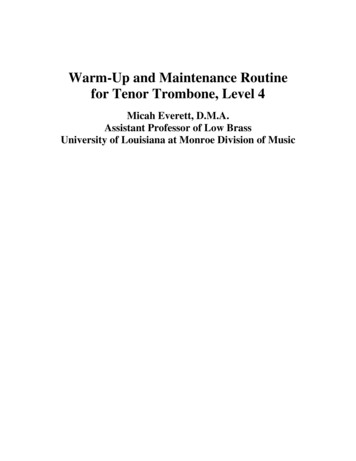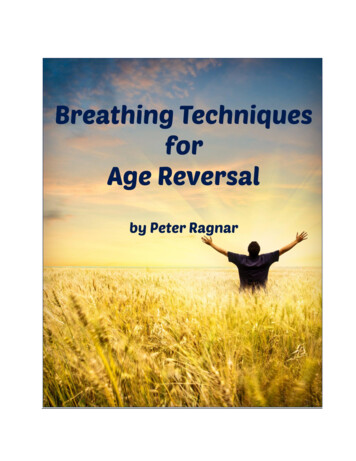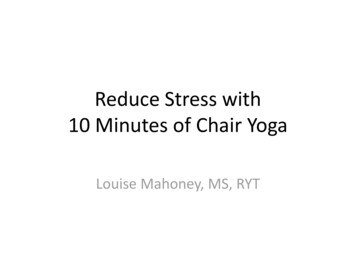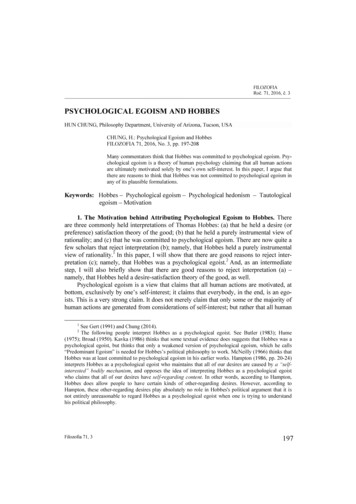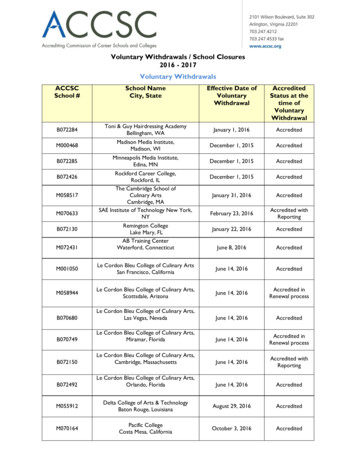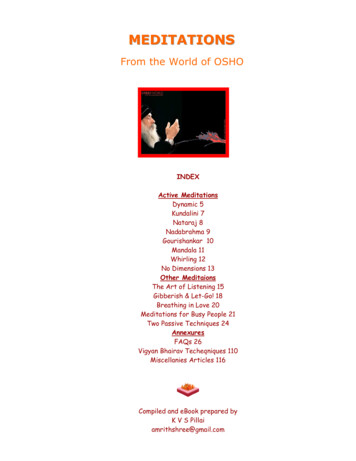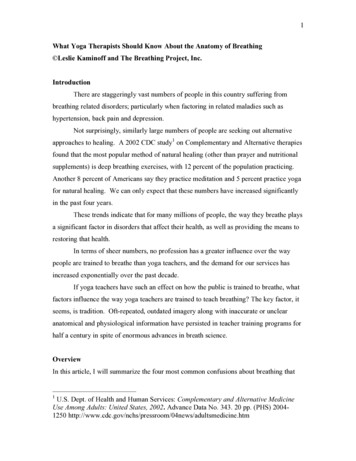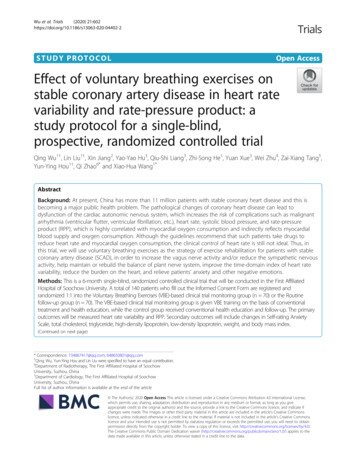
Transcription
Wu et al. Trials(2020) UDY PROTOCOLOpen AccessEffect of voluntary breathing exercises onstable coronary artery disease in heart ratevariability and rate-pressure product: astudy protocol for a single-blind,prospective, randomized controlled trialQing Wu1†, Lin Liu1†, Xin Jiang2, Yao-Yao Hu3, Qiu-Shi Liang3, Zhi-Song He1, Yuan Xue3, Wei Zhu4, Zai-Xiang Tang5,Yun-Ying Hou1†, Qi Zhao6* and Xiao-Hua Wang1*AbstractBackground: At present, China has more than 11 million patients with stable coronary heart disease and this isbecoming a major public health problem. The pathological changes of coronary heart disease can lead todysfunction of the cardiac autonomic nervous system, which increases the risk of complications such as malignantarrhythmia (ventricular flutter, ventricular fibrillation, etc.), heart rate, systolic blood pressure, and rate-pressureproduct (RPP), which is highly correlated with myocardial oxygen consumption and indirectly reflects myocardialblood supply and oxygen consumption. Although the guidelines recommend that such patients take drugs toreduce heart rate and myocardial oxygen consumption, the clinical control of heart rate is still not ideal. Thus, inthis trial, we will use voluntary breathing exercises as the strategy of exercise rehabilitation for patients with stablecoronary artery disease (SCAD), in order to increase the vagus nerve activity and/or reduce the sympathetic nervousactivity, help maintain or rebuild the balance of plant nerve system, improve the time-domain index of heart ratevariability, reduce the burden on the heart, and relieve patients’ anxiety and other negative emotions.Methods: This is a 6-month single-blind, randomized controlled clinical trial that will be conducted in the First AffiliatedHospital of Soochow University. A total of 140 patients who fill out the Informed Consent Form are registered andrandomized 1:1 into the Voluntary Breathing Exercises (VBE)-based clinical trial monitoring group (n 70) or the Routinefollow-up group (n 70). The VBE-based clinical trial monitoring group is given VBE training on the basis of conventionaltreatment and health education, while the control group received conventional health education and follow-up. The primaryoutcomes will be measured heart rate variability and RPP. Secondary outcomes will include changes in Self-rating AnxietyScale, total cholesterol, triglyceride, high-density lipoprotein, low-density lipoprotein, weight, and body mass index.(Continued on next page)* Correspondence: 734867417@qq.com; 648650801@qq.com†Qing Wu, Yun-Ying Hou and Lin Liu were specified to have an equal contribution.6Department of Radiotherapy, The First Affiliated Hospital of SoochowUniversity, Suzhou, China1Department of Cardiology, The First Affiliated Hospital of SoochowUniversity, Suzhou, ChinaFull list of author information is available at the end of the article The Author(s). 2020 Open Access This article is licensed under a Creative Commons Attribution 4.0 International License,which permits use, sharing, adaptation, distribution and reproduction in any medium or format, as long as you giveappropriate credit to the original author(s) and the source, provide a link to the Creative Commons licence, and indicate ifchanges were made. The images or other third party material in this article are included in the article's Creative Commonslicence, unless indicated otherwise in a credit line to the material. If material is not included in the article's Creative Commonslicence and your intended use is not permitted by statutory regulation or exceeds the permitted use, you will need to obtainpermission directly from the copyright holder. To view a copy of this licence, visit http://creativecommons.org/licenses/by/4.0/.The Creative Commons Public Domain Dedication waiver ) applies to thedata made available in this article, unless otherwise stated in a credit line to the data.
Wu et al. Trials(2020) 21:602Page 2 of 11(Continued from previous page)Discussion: This trial will carry out scientific respiratory exercise for patients with SCAD, which belongs to thecategory of active secondary prevention for patients, and changes from remedial to pre-protective. VBE is easy tooperate and is not limited by time and place. It is important and meaningful to carry out VBE for patients withSCAD. This study will provide considerable evidence for further large-scale trials and alternative strategies for therehabilitation nursing of patients with SCAD.Trial registration: Chinese Clinical Trials Registry, 1900024043. Registered on 23 June 2019.Keywords: Breathing, Stable coronary artery disease, Heart rate variability, Blood pressure, Myocardial oxygenconsumptionBackgroundStable coronary artery disease (SCAD) is one of the mostcommon types of coronary artery disease. It is characterized by chronic delay and high recurrence. Several studies[1–3] have demonstrated that pathological changes of coronary heart disease can lead to dysfunction of the cardiacautonomic nervous system, which is manifested as hyperactivity of sympathetic nerve and decreased excitability ofvagus nerve. Thayer et al. [4] concluded that autonomicnervous dysfunction leads to cardiac dysfunction and cardiovascular disease. Patients are also at an increased riskof complications such as malignant arrhythmia (ventricular flutter, ventricular fibrillation, etc.), increased heartrate, increased systolic blood pressure, and increased ratepressure product (RPP), which is highly correlated withmyocardial oxygen consumption and indirectly reflectsmyocardial blood supply and oxygen consumption [5],and is earlier than the change of electrocardiography(ECG). RPP is the product of heart rate and systolic bloodpressure and has been used as a non-invasive indicator toassess the level of myocardial oxygen consumption sincethe 1970s. The basis of the common pathophysiology ofthe risk complications such as angina pectoris and acutecoronary events is myocardial ischemia and hypoxia. RPPis closely related to myocardial oxygen consumption (R 0.90) [6], which is not only used to formulate the amountof exercise prescribed, but also the basis for evaluating thesymptoms and exercise ability of patients with cardiovascular disease. To some extent, it reflects the tolerance andsafety of certain rehabilitation methods of cardiovascularpatients. As a consequence, it is of utmost importance tono longer neglect the stability of autonomic nervous function during rehabilitation of SCAD. Heart rate variability(HRV) is recognized as a new non-invasive quantitativeevaluation method of autonomic nervous system functiondeveloped in recent years [7]. HRV refers to the small difference between cardiac cycles, which reflects the sympathetic and vagus nervous systems regulating the balancestate of the cardiovascular system [8]. It was shown to berelated to subtle time changes and patterns of each cardiaccycle, while the average heart rate can only appear normalor abnormal. Shen et al. [9] analyzed the results of 24-hdynamic electrocardiogram of 156 patients with coronaryheart disease and found that HRV decreased, ejection fraction decreased, and the incidence of cardiovascular eventsincreased.The research on the effect of respiration on HRV has become a hot topic in recent years [10, 11]. Previous studieshave demonstrated that respiration is one of important influencing factors for HRV [12, 13]. Cicek et al. [14] confirmed that deep and slow breathing can make people turnfrom depression to relaxation and improve the regulationfunction of human organs or autonomic nerves, so as toimprove the adaptability of human body. Voluntary breathing exercises (VBE) refers to a treatment or method of rehabilitation for adjusting breathing behaviors by traineesaccording to certain breathing patterns (frequency, depth,ratio of expiratory/inspiratory time, chest/belly style) without the use of auxiliary equipment or equipment [15]. Initially, VBE was applied in the prevention and treatment ofchronic obstructive pulmonary disease [16], chest surgery[17], and other diseases related to respiratory system. Subsequently, it gradually spread to the treatment of otherchronic diseases such as the endocrine and nervous systems[18, 19]. Some authors consider that VBE effectively improved quality of life, reducing symptoms associated with avariety of anxiety and depression [20, 21]. VBE is also applied to treat cardiovascular complaints, such as primaryhypertension [11, 16], heart failure [19, 22, 23], arrhythmia[24], and so on. Kawecka-Jaszcz et al. [23] found that respiratory exercise combined with exercise rehabilitation fora period of 10–12 week in patients with chronic heart failure had a better effect on ejection fraction and 6-min walktest, but this study failed to observe the functional changesof autonomic nervous function. Westerdahl et al. [25]showed that respiratory exercise for 2 weeks reduced systolic blood pressure in patients with coronary heart disease,but had no effect on heart rate and diastolic blood pressure,which may be closely related to the short intervention time.A study on the efficacy of VBE by Huang et al. [26] also reported significant reductions in heart rate and systolicblood pressure, and there were no effects on diastolic bloodpressure. The meta-analysis of results of independentbreathing exercise conducted by the research team in the
Wu et al. Trials(2020) 21:602Page 3 of 11previous stage proved this [27] (six randomized controlledtrial [RCT] articles, all in English), VBE had significant effects on improving resting heart rate, systolic blood pressure, and diastolic blood pressure in patients with coronaryheart disease.However, more research is necessary regarding the effectof VBE on SCAD. In 2014, the American College of Cardiology (ACC) and the American Heart Association (AHA)[28] pointed out that drug therapy and lifestyle interventionare key to controlling or delaying the stable progression ofcoronary heart disease, reducing complications, disabilityrate, and mortality rate. As a lifestyle intervention, VBE hasbecome a new way of comprehensive intervention for coronary heart disease. To date, there are no definite data onthe effect of VBE in patients with SCAD, particularly in theChinese population. Thus, we present the protocol of asingle-blind RCT to investigate the effects of VBE onSCAD. We hypothesize that VBE is effective for the management of secondary prevention of coronary heart disease.increase activity in the vagus nerve and/or reduce sympathetic nervous activity, help maintain or rebuild thebalance of the central nervous system, improve the timedomain index of HRV in patients with SCAD, reducethe burden on the heart, and relieve patients’ anxietyand other negative emotions (Fig. 1).Research hypothesisMethodsOn the basis of routine rehabilitation guidance, in thisstudy VBE will act as an aid in the strategy of exerciserehabilitation in patients with SCAD, in order toStudy design and settingFig. 1 Schematic diagram of research hypothesisObjectivesThe main goal of this RCT is to evaluate the effect ofVBE on HRV and myocardial oxygen consumption inpatients with SCAD. First, HRV will be measured usingthe generally recommended time-domain analysis in 24h; second, since RPP are highly correlated with myocardial oxygen consumption, it will be used as an indicatorto estimate oxygen consumption of the myocardium.The second objective is to explore the effect of VBEon reducing anxiety in patients with SCAD. Anxiety willbe measured using the Self-rating Anxiety Scale (SAS)developed by Zung [29] in 1971.This is a 6-month, single-blind RCT that will be conducted in the First Affiliated Hospital of Soochow
Wu et al. Trials(2020) 21:602University. Written informed consent will be obtainedfrom each individual by the researcher after the individual has received a sufficient explanation and period oftime in which to make a thoughtful decision. All the patients will be randomized 1:1 into the VBE-based clinicaltrial monitoring group (n 70) or the Routine follow-upgroup (n 70). The VBE-based clinical trial monitoringgroup is given VBE training on the basis of conventionaltreatment and health education, while the control groupreceived conventional health education and follow-up.The two groups will be followed up for 3 months (Step1). Considering the ethics and the fairness of the resources, we refer to the step-wedge design [30] and givethe control group the same VBE guidance and follow upfor another 3 months (Step 2) (see the flow diagram inFig. 2). The Cardiovascular Medicine Department of theFirst Affiliated Hospital of Soochow University isFig. 2 Technology roadmapPage 4 of 11currently the largest cardiovascular disease diagnosis andtreatment center in South Jiangsu Province, China. Thedepartment carried out the first PTCA surgery in Chinain 1983. It has 180 beds, including 20 fully equippedCoronary Care Unit (CCU) beds, four cardiaccatheterization rooms with advanced equipment, as wellas a cardiac supersonic room and cardiac function room,and 1500 m2 cardiovascular laboratory. Annually, anaverage of 100,000 outpatients, 5000 open-heart surgerycandidates, and 400 emergency operations are treated inthe department.Sample sizeThe sample size estimation was carried out using GPower 3.1.9.2 software of two population means formulae [31]. We hypothesized that the VBE-based clinicaltrial monitoring group would be superior to the control
Wu et al. Trials(2020) 21:602group in terms of HRV and myocardial oxygen consumption; the effect rates were calculated with a 0.447effect size at a 5% significance level and a power of 0.8.This means a sample size of 118 individuals per groupwas required. With an estimated 20% dropout, the finalsample size of 140 individuals was determined (70 ineach group).ParticipantsInclusion criteriaPatients will have to meet the following eligibility criteriato be included in the study:1. Age 45–75 years2. Meeting the diagnostic criteria of SCAD formulatedby by the interventional cardiology group of thecardiovascular disease branch of the ChineseMedical Association, the Atherosclerosis andCoronary Heart Disease Group, and theProfessional Committee for the Prevention andTreatment of Thrombosis of the cardiovascularphysicians branch of the Chinese MedicalAssociation [32]3. Heart rate 60 beats/min [33]4. Living in Suzhou for at least 6 months from thestart of the trial5. Those who are sane, rational, and able tocommunicate verbally6. Those who agree to participate and provide writteninformed consentExclusion criteriaPatients will be excluded from the study if:1. Revascularization has been carried out orconducted in follow-up2. Combined arrhythmia shows on an ECG3. Any self-reported respiratory disorder4. Severe liver and kidney diseases5. Diagnosed with hypothyroidism or currently takingthyroid medications6. Diagnosed with moderate or below anemia(hemoglobin [Hb] level 9 g/dL)7. With any mental disorders (for example, majordepressive disorder, anxiety disorder, substance use,etc.) in the past 12 months8. Pregnancy and/or practicing yoga/meditation/relaxation/mindfulness on a regular basis9. Other reasons determined by the investigators thatmake participation in the clinical trial inappropriateWithdrawal criteriaParticipants who meet the criteria summarized beloware withdrawn from the study. The individuals who arePage 5 of 11withdrawn after randomization will be followed up foroutcomes. Reasons for withdrawal will be documentedin follow-up records and data will be analyzed using theintention-to-treat (ITT) principle [34]:1. Failed to exercise for 2 weeks in a row2. Failed to have three consecutive telephoneconnections during the follow-up period3. Patients who quit for various reasonsRandomizationEligible participants who will provide written consent toparticipate in this clinical trial will be randomly assignedto a treatment group or a control group with an allocationratio of 1:1. Random sequencing will be generated by anindependent professional statistician using the EXCEL togenerate 140 random numbers. The serial numbersassigned to each patient are kept in an opaque, sealed envelope. All the participants will be asked to pick onesealed envelope and pass it onto the research study teammember. The participants will be randomly assigned totwo groups. Each group will have 70 individuals.BlindingThe research study team member who enters information about a participant’s eligibility is the only person toknow the participants’ allocation until the participanthas completed the entire protocol. The research teammember involved in the subjective efficacy assessmentsis blinded to the participant’s group allocation to receiveVBE or conventional treatment. Participants are similarly blinded to their own group allocation and they willbe cautioned not to remark on the VBE exercises thatthey receive to the research study team member performing the outcome measures. Results from the outcome measures will not be revealed to the participantsuntil after all recruitment, treatment, and assessmentshave been performed for all 140 participants.ProceduresStudy scheduleThe items to be measured at each visit are presented inTable 1.Baseline assessmentAfter the screening visit, if a participant fulfills the inclusion criteria and has signed the informed consent form,he will be assigned to the baseline assessment. The baseline assessment takes place at visit 1. Baseline assessment includes patients’ basic information (such as age,gender, marital status, occupation, level of education,dietary habits, income, family history, co-morbidities,number of diseased coronary vessels, previous myocardial infarction, history of stent implantation, etc.), heart
Wu et al. Trials(2020) 21:602Page 6 of 11Table 1 Schedule of enrollment, intervention, and assessmentScreeningVisit 1(day 5 to 2)Informed consentXInclusion/exclusion criteriaXRandomizationVisit 2(day 0)Close-outVisit 3(week 1)Visit 4(week 2)Visit 5(week 3)Visit 6(week 4)Visit 7(week 8)Visit 8(week 12)XInterventionVital signsBody measurementPost allocationaBasic informationbXXXXXXXXXXXXXXXXXXXXXXXXHeart function classificationXMedical historycXGeneral physical examinationXXHRVXXRPPXSelf-rating Anxiety ScaleXLaboratory testsdXHeart Doppler ultrasoundindexeseXXXXXCompliance monitoringAdverse event monitoringXXXXXXXXXaHeight and weight, but only weight for visit 2 and follow-upbAge job, education level, dietary habit, smoking habits, drinking habits, etc.cIncluding general medical history and family history of coronary heart diseasedIncluding triglyceride, total cholesterol, high-density lipoprotein, low-density lipoprotein, and fasting plasma glucoseeIncluding left ventricular ejection fraction, left atrium dimension, left ventricular end-diastolic dimension, left ventricular end-diastolic volume, left ventricularend-systolic volume, etc.function classification, physical anthropometry indexes(height, body weight, blood pressure, heart rate, BMI,RPP, and HRV), heart Doppler ultrasound indexes (leftventricular ejection fraction, left atrium dimension, leftventricular end-diastolic dimension, left ventricular enddiastolic volume, left ventricular end-systolic volume,etc.), testing items (triglyceride [TG], total cholesterol[TC], HDL-C, LDL-C, and fasting plasma glucose), questionnaires (SAS).Intervention groupAfter enrollment, the intervention group was given thefollowing measures on the basis of receiving the routinehealth education. Each patient in the intervention groupwill be assigned a health management document andhave a follow-up timetable.1. Development and distribution of manuals: theChinese Biomedical Literature Database (CBM) willbe searched using the Chinese search terms “healthmanagement,” “diet,” “exercise,” “heart rate,” and“blood pressure” and the Cochrane Library, JBI, andMedline will be searched using the correspondingEnglish search terms. After two rounds of expertconsultation, the health education manual forpatients with SCAD will be constructed anddistributed to each patient in the interventiongroup upon discharge.2. One-to-one telephone follow-up or home visit: thepatient will be followed up after discharge. Followup time is 3 months for a total of 12 weeks (once aweek in the first month and once a month after thatuntil 3 months). Two follow-up methods will beadopted: telephone and home visit. The telephonefollow-ups last about 5–10 min each. Holding timecould be extended if there is any problemconsultation. Home visits will be scheduled withpatients in advance and will last about 30–60 mineach. During the follow-up, we will address thepatient’s doubts and evaluate the effectiveness ofthe intervention.3. VBE guidance: before VBE, patients should rest for5 min and then do it in a well-ventilated room withappropriate temperature. The researchers helppatients take comfortable positions (supine, repose,and standing are all acceptable, sitting isrecommended), straighten their head and back, andrelax their whole body. The researchers instruct
Wu et al. Trials(2020) 21:602patients to extend the duration of exhalation andinhalation, and to minimize the breathing rate to 6breaths/min. Participants practice silently countingfrom 1001 to 1004 on the inhale phase and 1001–1006 on the exhale phase to control the breathingrhythm and slow down the frequency. Participantsare also encouraged to use abdominal breathing (abulge in the abdomen when inhaling and adepression when exhaling) to deepen breathingdepth and reduce breathing rate. Practice time: thetotal time per day is more than 30 min [25], whichcan be delivered in batches, but for at least 10 minat a time and at least five times a week [12].Attention: The participants should breathe in and outof the nose during the whole process. The intensity ofthe exercise should not cause breath-holding or anyphysical discomfort. If discomfort occurs, participantsmay rest for a while and continue the exercise if no discomfort is present. For the first 3 days of the study, participants are asked to complete exercises in anoutpatient classroom and the researchers will assesswhether the exercises are correct or if they need to correct wrong breathing patterns.4. Exercise log: each participant is given an exerciselog and asked to record the number and time ofexercise every day. These data can be used to assessintervention compliance.5. Network support: the research group will makeself-breathing exercise material or video andtransmit it to each participant through the network,so that participants could browse at any time.Control group1. Routine education: on the first day after enrollment,researchers explain relevant knowledge of SCAD topatients, including risk factors, diet, weight control,physical exercise, blood pressure, lipid management,etc.2. Telephone follow-up: once per month for 3 months,each call lasting about 5–10 min, receivingtelephone counseling from patients.3. Post-intervention: the control group will be giventhe same intervention measures 3 months later, andthe effects of the control group will be comparedbefore and after the intervention.OutcomePrimary outcome measureThe change in the HRV and RPP will be used as the primary outcome measure. The mean difference betweenthe change scores of the two groups will be calculated.Page 7 of 111. HRV: currently, a 24-h time-domain analysis indexis generally recommended for HRV detection [35].All patients will be tested by 12-channel dynamicECG (TLC5000) to detect the time-domain index ofHRV between visit 1 (baseline) and visit 8 (aftertreatment). During the examination, participantsare required to have adequate sleep overnight,maintain a quiet and peaceful environment, avoidextremely intense exercise, avoid changes in postureand mood swings, avoid drinking stimulating drinkssuch as coffee, and try not to take drugs that mayinterfere with autonomic nerves.Indicators include: (1) standard deviation of normalto-normal (SDNN), SDNN is the SD of 24 h continuousRR interval; (2) SD of average 5-min normal-to-normalintervals (SDANN), SDANN is the SD of the mean ofcontinuous RR intervals every 5 min for 24 h; (3) squareroot of the mean squared differences of successivenormal-to-normal intervals (RMSSD), RMSSD is theroot mean square of all RR intervals within 24 h; (4) percent of the number whose difference between adjacentnormal-to-normal intervals are 50 ms (PNN50),PNN50 is the percentage of sinus beats in which the difference between the two adjacent normal RR stages was 50 ms at 24 h; (5) mean of SDs of normal-to-normalintervals for each 5-min period (SDNNindex), SDNNindex is the mean of the SDs for 5-min segments.All dynamic electrocardiograms are completed by professionals in the electrocardiogram room of the samehospital; HRV time-domain indexes are automaticallyanalyzed and calculated by the electronic computer.2. RPP: RPP is used to estimate myocardial oxygenconsumption [36]. The normal value of RPP is 12,000, and the smaller the product, the morestable the patient’s condition. In this study, anelectronic blood pressure monitor (OMRON,HEM-4011C) will be used to measure patients’heart rate and blood pressure at visits 1, 4, 7, and 8.The measurement time is scheduled to be from14:002 to 15:00 and the room temperature ismaintained at about 25 C in the same outpatientclassroom. After sitting for 15 min, the patient willbe measured at the right elbow. Patients shouldensure that they do not eat or drink strong tea,coffee, or other stimulating drinks 1 h before themeasurement.Secondary outcome measure1. SAS: the Zung SAS is an anxiety measure designedby William WK Zung in 1971 to quantify the levelof anxiety for patients experiencing anxiety-related
Wu et al. Trials(2020) 21:602symptoms [28]. The SAS test is self-administered,with each response using a 4-point scale, rangingfrom “none of the time” to “most of the time.”There are 20 questions with 15 increasing anxietylevel questions and five decreasing anxietyquestions. According to SAS standard scores, therespondents are divided into four categories: nosymptoms of anxiety ( 50 points); mild anxiety(50–59 points); moderate anxiety (60–69 points);and severe anxiety ( 70 points). The scale has beenwidely used in China and its validity and reliabilityhave been verified.2. Metabolic profile: TC, TG, HDL-C, and LDL-C.3. Body composition: weight and BMI.Safety outcome measuresThe safety assessment will be performed for the participants who have received VBE training more than once.The individuals’ vital signs and general physical statuswill be examined at every visit. The occurrence of adverse events (AE) will be checked at visits 3, 4, 5, 6, 7,and 8. The investigators should educate the individualsto report any AE that occurs after training. All AEs thatoccur after the start of this trial should be documentedin the case report form, whether or not they are relatedto VBE. All AEs will be evaluated for causalrelationships.Protocol supplementaryThe researchers will collect the exercise logs of the patients after 2 weeks of exercise for the purpose of calculating exercise compliance. The rate of compliance willbe calculated as: compliance (%) [continuous regularexerciser/total intervention group] * 100. Clinical trialswill be continued only if compliance is 70%.Data management and quality control of dataBoth the electronic medical record and web-based electronic database will be used to manage individual participant data. To protect confidentiality, the files arestored in a secure and locked place and manner. Qualitycontrol of the data will be handled at two differentlevels: the investigators will be required to ensure the accuracy of the data as the first level of control when theyinput the records in electronic medical record. The second level will include data monitoring and validationthat will be carried out by two full-time graduate students who will not be involved in the intervention ordata collection. The database will be locked under theorders of the Principal Investigator. All the data will bedouble-inputted into the computer using Epidata3.0software. After checking and proofreading, SPSS statistical software (SPSS Inc., Chicago, IL, USA) will be usedfor data analysis. Nobody can have access to thePage 8 of 11database without authorization from the PrincipalInvestigator.Statistical analysisThe Kolmogorov–Smirnov test and p-p diagram analysiswill be used to test the normal distribution of continuous variables. Continuous variables will be presented bymean SD if they are normally distributed. Mann–Whitney U test will be used and expressed by median withinterquartile range if they are not normally distributed.Chi-square or Fisher’s exact tests will be used for comparison of dichotomous data. Both per-protocol (PP)and ITT analyses will be used to determine the robustness of the evidence. An independent statistics expertwill perform the statistical analysis in a blind manner.All statistical analyses of the data will be performed byusing SPSS software version 21.0 (SPSS Inc., Chicago, IL,USA). A multivariate analysis will be performed to identify the factors associated with outcome indicators. Statistical significance is obtained with a P value 0.05.DiscussionHRV is currently recognized as one of the indicatorsreflecting impaired autonomic nervous function [37],which is affected by sympathetic and parasympatheticnerves and shows fluctuations. Studies [38] have shownthat myocardial ischemia caused by coronary heart disease promotes a long-term high level of sympatheticnerve activity, changes the normal balance between sympathetic and vagus nerves, and shows a decrease in HRVon the dynamic ECG.Ferrari et al. [39] found that multiple time-domain andfrequency-domain indexes of HRV in patients with coronary heart diseas
Stable coronary artery disease (SCAD) is one of the most common types of coronary artery disease. It is character-ized by chronic delay and high recurrence. Several studies [1-3] have demonstrated that pathological changes of cor-onary heart disease can lead to dysfunction of the cardiac autonomic nervous system, which is manifested as hyper-
